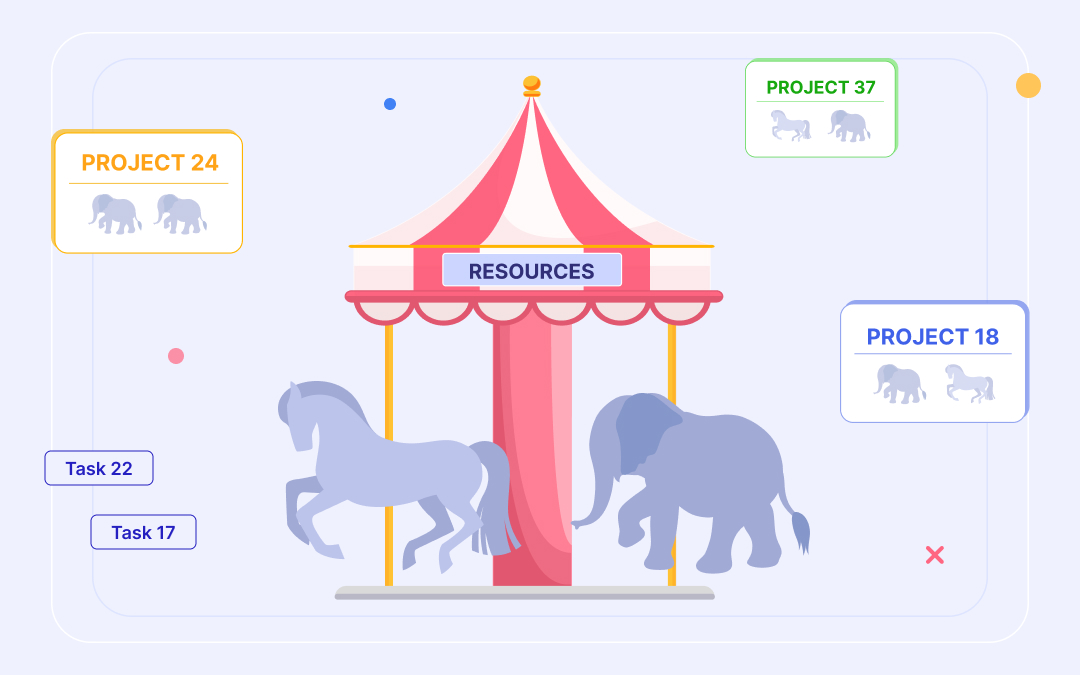Ensuring fruitful work on a project isn’t easy – you need to assign resources properly so that they are maximum efficient and aren’t overloaded with work. In addition, project managers need to ensure that the project will be delivered on time and within budget. To meet all these requirements, project managers sometimes use resource scheduling.
Read further to learn more about this technique, its advantages and disadvantages, and find out the alternative ways to ensure efficient resource allocation and smooth workflow.
What Is Resource Scheduling in Project Management?
Project resource scheduling involves determining each task’s start and finish dates according to the availability of resources needed for their delivery and creating a schedule based on this information. Such a technique allows you to monitor the project timeline from start to finish and make sure that the project resources (employees, equipment, facilities, etc.) are utilized efficiently. Most often, resource scheduling is used for large and complex projects with a limited number of resources.
Resource scheduling steps
In a nutshell, scheduling resources can be represented as a series of the following essential steps.
- Dividing the project scope into the list of tasks that must be completed and estimating their duration (can be expressed in days, hours, or man-hours).
- Identifying constraints for each task: a deadline, certain skills required to complete the task, employee availability, etc.
- Determining the resource demand: the types and number of resources required for completing each task.
- Analyzing resources’ capacity: the amount of work they typically perform each day, their current and forecasted workload, any planned days off, new hires, etc.
- Matching available resources with the listed tasks – assigning each resource to perform a specific task at a specific date. If a resource has no capacity for completing the task and there are no alternatives, this task will be postponed and scheduled for the dates when this employee is available.
Let’s now review the two main methods of scheduling project resources.
Resource scheduling methods
There are two methods of scheduling project resources: time-constrained and resource-constrained scheduling. The choice of the method depends on the constraint that is considered the most essential for the project.
- Time-constrained scheduling implies that you cannot change the project timeline so you schedule resources so as not to miss project deadlines. When applying time-constrained resource scheduling with a limited number of people, resource managers may require additional resources to be able to complete the project on time. As a result, this may lead to exceeding the project budget.
- In resource-constrained scheduling, it’s resource capacity and availability (i.e., resource constraints) that matter most. You can change the project’s timeline, e.g., start or finish it later depending on the availability and capacity of employees working on it. This type of resource scheduling protects people from overload but can lead to missing a project’s due date.
Now that the essence and importance of resource scheduling are clear, let’s review the technique’s main advantages and disadvantages.
Advantages and Disadvantages of Resource Scheduling

Benefits of resource scheduling
We can distinguish the following advantages of scheduling resources.
- The team members know their task completion deadlines, which in turn contributes to better predictability of the workflow for them.
- Proper resource scheduling takes team members’ capacity into account, which helps ensure a more balanced workload, minimizes the probability of overload, and contributes to more efficient resource utilization.
- It will be easier for a project manager to monitor the general project schedule to make sure that the project’s due dates won’t be missed.
- Scheduling material resources (if they are required for project completion) will be a good way to ensure their availability and proper distribution across project tasks, which in turn reduces the probability of delays.
Disadvantages of scheduling resources
However, creating resource schedules isn’t the only right solution to assign resources in the most efficient way. Let’s take a closer look at the limitations of the technique.
-
It’s time-consuming.
You have to gather and analyze lots of data regarding employees’ availability, which becomes especially cumbersome when the number of employees involved in a project is large.
-
It’s too deterministic.
There are plenty of reasons why changes will have to be made to this schedule, which you cannot predict at the scheduling stage. Also, resource scheduling doesn’t take into account the uncertainty that usually accompanies projects, especially when a great number of people are involved. Such a deterministic approach won’t allow you to respond to necessary changes properly.
-
It can lead to delays.
Creating a resource schedule involves determining each task’s start and finish dates; however, it can be difficult to estimate the task duration accurately. For example, when a team member is going to work on an assignment for the first time, his or her estimation will be far from accurate which can result in delays.
-
It can reduce the team member’s productivity.
Setting task deadlines can reduce the fruitfulness of project work due to student syndrome and Parkinson’s law. In the first case, the team members can procrastinate and start work on the task as close to the deadline as possible. In the second case, the work on a task will expand to fill all the time allotted for its completion, even if it requires less time in reality.
-
It’s not suitable for a multi-project environment.
In a multi-project environment with a shared resource pool, scheduling resources is an exhausting process. First, it can be explained by numerous dependencies between projects: e.g., task dependencies or shared resources. In this case, the schedules will overlap or changes made to one project will affect the whole project environment and you’ll have to reschedule a huge number of activities. Second, it’s too complex and time-consuming to create a schedule with regard to every person’s availability, capacity, and other projects’ schedules.
As we see, the disadvantages of resource scheduling are rather remarkable, especially when you work on multiple concurrent projects with shared resources. Jump to the next section to learn about an alternative approach to the resource scheduling process provided by resource management software.
An Alternative Approach to Resource Scheduling: Epicflow’s Solution

To overcome the limitations of resource scheduling, assign resources in the most efficient way, and ensure timely project completion, it’s a good idea to choose the appropriate resource scheduling software. Epicflow is a resource management solution that facilitates the timely delivery of every project in a multi-project environment thanks to a unique approach to project and resource management. Here are the main capabilities that increase the efficiency of resources and work on projects in general.
Focusing on task priorities instead of task deadlines
In our system, there are no deadlines for individual tasks. Instead, Epicflow’s task management functionality sets task priorities across the whole project environment and provides each team member with a prioritized task list. In addition, our approach to estimates implies that a team member should complete the highest priority tasks as soon as possible to eliminate the harmful effects of Student syndrome and Parkinson’s law. When changes to the project environment occur, the priorities are automatically recalculated, which means that changes won’t ruin the schedule and/or derail a project.
Predicting potential resource bottlenecks
Epicflow’s Future Load Graph is capable of predicting employees’ capacity and future workload visualization in real time. It helps you determine future resource requirements and staff future projects in such a way that there won’t be any overloaded or idle team members that will later become bottlenecks for the workflow.
Resource allocation advisor
The system automatically matches a task with an available employee who has the necessary skill sets and capacity for its completion, which significantly simplifies the allocation of resources and increases its efficiency.
Providing relevant information on resource availability
Epicflow integrates with human resource management systems, so all the employees’ days off, vacations, sick leaves, or other availability changes will be taken into account in the process of resource allocation, which eliminates the risk of assigning a task to an unavailable employee.
Helping to prepare for uncertainty
You can’t predict uncertainty, but you can prepare for it so that it won’t result in unpleasant surprises for project flow. In Epicflow, you should add the time buffer to the milestones and the due date of your project, so, if unexpected situations occur, you’ll have a leeway to respond to them. Epicflow can also reduce uncertainty in decision-making.
In its What-if Analysis mode, you can test different management decisions (reassigning resources, moving milestones, adding more resources, etc.) and choose the most reasonable one.
Finally, when you manage a project portfolio, Epicflow’s Project Staggering feature lets you reschedule lower-priority projects for later so that you can free resources’ capacity for working on the highest-priority projects and delivering them on time.
Managing material resources
Similarly to assigning human resources, in Epicflow, you can assign material resources to project tasks. This will help you keep track of material resource consumption and ensure that all the necessary equipment and/or facilities are available at the time they’re required for project work.
Therefore, leveraging a resource management solution like Epicflow can ensure effective resource scheduling when you manage multiple projects – it provides the benefits of resource scheduling and at the same time helps overcome the drawbacks of this technique. As a result, you can ensure smooth project flow, the productivity of resources, as well as timely and successful completion of every project in the portfolio. Contact our experts to learn more about how Epicflow can help you manage multiple projects and their shared resources successfully.

